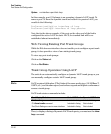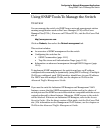
11-23
Port Trunking
Port Status and Configuration
Trunk Group Operation Using the “Trunk” Option
This method creates a trunk group that operates independently of specific
trunking protocols and does not use a protocol exchange with the device on
the other end of the trunk. With this choice, the switch simply uses the SA/DA
method of distributing outbound traffic across the trunked ports without
regard for how that traffic is handled by the device at the other end of the
trunked links. Similarly, the switch handles incoming traffic from the trunked
links as if it were from a trunked source.
Use the Trunk option when you are trying to establish a trunk group between
the switch and another device, but the other device’s trunking operation fails
to interoperate properly with LACP trunking configured on the switch itself.
How the Switch Lists Trunk Data
Static Trunk Group: Appears in the menu interface and the output from the
CLI show trunks and show interfaces commands.
Dynamic LACP Trunk Group: Appears in the output from the CLI show lacp
command.
Outbound Traffic Distribution Across Trunked Links
Both trunk group options (LACP and Trunk) use source-destination address
pairs (SA/DA) for distributing outbound traffic over trunked links.
Interface Option Dynamic LACP
Trunk Group
Static LACP
Trunk Group
Static Non-Protocol
Trunk Group
Menu Interface No Yes Yes
CLI:
show trunks No Yes Yes
show interfaces No Yes Yes
show lacp Yes Yes No
show spanning-tree No Yes Yes
show igmp No Yes Yes
show config No Yes Yes


















